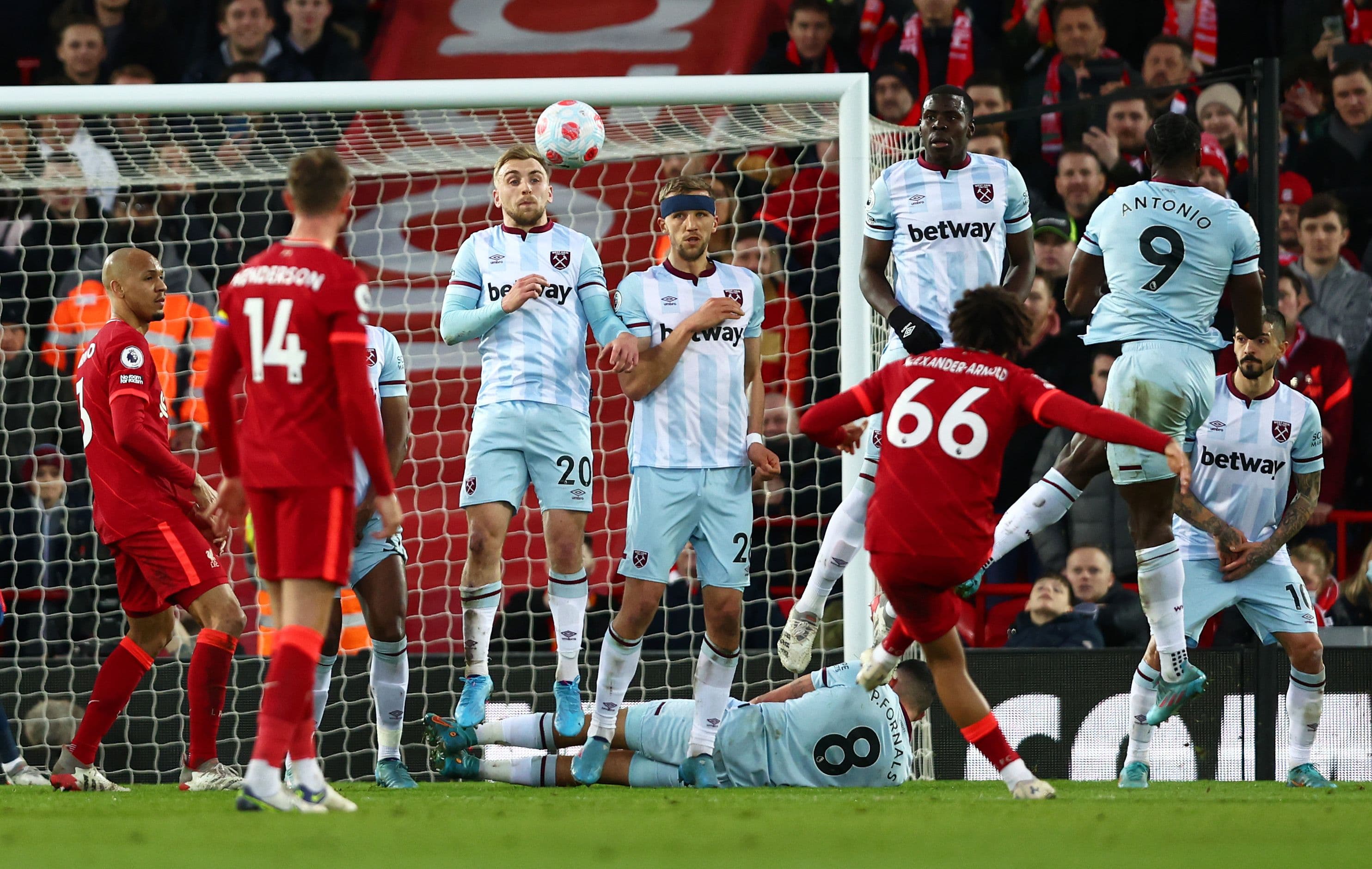Football
What is the Free-Kick Rule in Football?
Football is full of laws. The most contentious rule revolves around fouls that lead to penalties and free kicks. What is the free-kick rule in football? Find out here!

Image Credits: Clive Brunskill/Getty Images
A free-kick is awarded for a foul in association football. Free kicks can be given on any part of the field. However, fouls on attackers inside the defending 18-yard area result in a penalty. Rarely, free kicks are awarded inside the defending team’s big box. There are two types of free kicks: direct and indirect. SportsBoom looked at the details of the rules in football to find out what a free-kick is.
Definition of the Free-Kick in Association Football
The International Football Association Board (IFAB) is an international, self-regulatory governing body for the laws of association football. The IFAB was founded in 1886 to establish a standardised regulation for the Laws of the Game. The International Federation of Association Football (FIFA) is the governing body for world football. FIFA has recognised the IFAB’s authority over the laws of association football since 1904.
Law 13.1: Types of Free Kicks
The IFAB determines in Law 13.1: Types of Free Kicks, that a free-kick is “awarded to the opposing team of a player, substitute, substituted or sent-off player, or team official guilty of an offence.” The result of the foul will be either a direct or indirect free-kick. Free kicks are awarded throughout a match. They are awarded for infringements the players commit on the opposition during the game.
A free kick is the most common method of restarting the game. Some matches have more free kicks than corners or goal kicks. Goals can be scored from both set pieces. An indirect free-kick can only be scored once two or more players have touched the ball, or it will be ruled out by the referee.

Image Credits: Rob Newell - CameraSport via Getty Images
What is the Difference Between A Direct and Indirect Free-Kick?
Law 12.1: Fouls and Misconduct | Direct Free-Kick
The IFAB states in Law 12.1: Fouls and Misconduct, that a “direct free kick is awarded if a player commits any of the following offences against an opponent in a manner considered by the referee to be careless, reckless, or using excessive force: charges, jumps at, kicks or attempts to kick, pushes, strikes or attempts to strike (including head-butt), tackles or challenges, trips or attempts to trip” an opposing player.
Law 12.1: Fouls and Misconduct | Indirect Free-Kick
The IFAB states that an indirect free-kick will be awarded by the referee if a player “plays in a dangerous manner, impedes the progress of an opponent without any contact being made, is guilty of dissent, using offensive, insulting or abusive language and/or action(s) or other verbal offences.”
Indirect free kicks will also be awarded if players “prevent the goalkeeper from releasing the ball from the hands or kicks or attempts to kick the ball when the goalkeeper is in the process of releasing it, initiates a deliberate trick for the ball to be passed (including from a free kick or goal kick) to the goalkeeper with the head, chest, knee etc. to circumvent the Law, whether or not the goalkeeper touches the ball with the hands; the goalkeeper is penalised if responsible for initiating the deliberate trick, commits any other offence, not mentioned in the Laws, for which play is stopped to caution or send off a player.”

Image Credits: Lutz Bongarts/Bongarts/Getty Images
Roberto Carlos Scored the Most Incredible Free-Kick in Football History
1997 Tournoi de France: France vs Brazil, Stade de Gerland, Lyon
Free kicks have never been the same since Roberto Carlos defied the laws of physics in the 1997 Tournoi de France. France hosted Le Tournoi a year before the 1998 FIFA World Cup. The four-nation mini-tournament also featured Brazil, Italy, and England. In the first match of the mini-tournament, France played the defending world champions - one of the best teams in the world - in Lyon on October 3.
The match would be forgotten, if not for Carlos’ incredible direct free kick from 35 metres out. Twenty-two minutes had elapsed when the Brazilian defender, who went on to be one of the best defenders in the world, scored what pundits described as “the goal that defied physics” and the “impossible strike”. The curve and speed of the free-kick left France goalkeeper Fabien Barthez bamboozled.
Juninho Pernambucano and Cristiano Ronaldo perfected the “knuckleball” free-kick. Pernambucano and Ronaldo are two of the best dead-ball specialists in football history. They are also on the top 10 list of most free kicks scored in history. A “knuckleball” free-kick is hit from front on, with the top of the instep, striking the ball below the centre, near the bottom.
The idea is to blast the ball up and over the wall. This style of strike enables the ball to be hit with pace and power, and once it is over the wall, the ball dips over or past the goalkeeper. Carlos struck the ball with force, on the outside of his boot, enabling the ball to swerve. The flight and trajectory of the Brazilian’s free-kick, however, has had scientists and physicists intrigued for decades.
Many research studies on the free-kick have been done, including one of the most clinical and respected studies conducted by four French scientists - Guillaume Dupeux, Anne Le Goff, David Quere, and Christophe Clanet. The study was published in the New Journal of Physics in September 2010.
The ball swerved around the wall, and boomer-ranged back towards Barthez’s goal, before going in off the post. In a 2017 interview with ESPN Brasil, Carlos said: “To be honest, until this day I don't know how I did that.” It was a beautiful goal. It required a lot of training and hard work throughout my career. But that hard work paid off, as I was able to score such a wonderful goal, which was a special moment for me.”

Image Credits: PASCAL GEORGE/AFP via Getty Images
Robert Pires, who was new to international football, and standing on the edge of the wall, gave Sky Sports his reaction in an interview on June 3, 2017, the twentieth anniversary of the goal. “The ball curved between me and the wall, so I had a very good view of it,” he told the British broadcaster. “We knew Roberto Carlos had a powerful shot but to hit the ball like that was amazing. I remember he struck it with the outside of his boot. We were surprised with the trajectory of the ball and how it curved. It was unthinkable.”
Carlos never attempted to take another free-kick the same way because he thought it would be impossible to pull it off again. He did, however, say he scored similar goals in training. “Goals like that come around only once in your career. I hit a few like that in training, with and without a wall, but never with as much swerve and spin,” he told football magazine FourFourTwo in an interview back in 2015. “It was a beautiful goal – unforgettable.”
“I never tried to kick like that again,” he told ESPN, “because I know I would never have scored. There are lots of good kickers nowadays. It might take some time, but someday someone will score a similar goal. But I was the first.” Despite many people thinking the strike cannot be replicated, scientists and physicists disagree. “What happened that day was so special,” researcher Quere told The Associated Press. “We are confronted with an unexpected law of physics, but it's possible to see this again.”

Kaylan Geekie is a sports fanatic. He attended Durban High School before moving to Scotland, where he lived for 15 years. During his time in the United Kingdom, Kaylan graduated with a first-class BA Honours Degree in Sports Journalism at the University of the West of Scotland. Kaylan worked for nine years as the Match-Day Editor of SuperXV.com, reporting on Super Rugby, The Rugby Championship, the 2015 Men's Rugby World Cup and the 2017 British & Irish Lions series for the website.